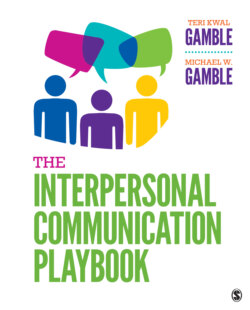Читать книгу The Interpersonal Communication Playbook - Teri Kwal Gamble - Страница 112
На сайте Литреса книга снята с продажи.
Learning Objectives
ОглавлениеAfter completing this chapter, you should be able to
1 Explain the nature of perception and its relationship to reality
2 Describe the perception process in action
3 Explain how schemata, perceptual sets, unconscious bias, ethnocentrism, and stereotypes influence perception
4 Distinguish among the following perceptual barriers: fact-inference confusions, allness, indiscrimination, frozen evaluations, snap judgments, and blindering
5 Discuss how culture and gender influence perceptions of social experience
6 Discuss how media and technology influence perceptions of social experience
7 Identify strategies you can use to enhance your perceptual abilities
We don’t see things as they are. We see them as we are.
—Anais Nin
How accurate are the quick perceptions we form of each other? And how good are the decisions we make based on these instant perceptions? Consider speed dating, for example. In speed dating, we rely on “thin slicing”—basing our impression of another person solely on an abbreviated behavioral glimpse.1 During a speed-dating event, we may interact round-robin style with as many as 12 possible partners, with each individual “date” lasting on average from 3 to 8 minutes. While some believe we should be able to make judgments about how close we want to become with a potential dating partner during such a short time—even as short as 30 seconds—others are not so sure.2
Interestingly, researchers report that thin slicing produces judgments that are pretty accurate.3 Within 30 seconds, speed-dating participants find themselves either attracted to someone or not. Speed daters acknowledge a lack of attraction or negative physical qualities as potential partner turnoffs, with women reporting three times as many negative judgments as do men. Reported turn-ons are physical attractiveness and positive behavior and demeanor, including positive perceptions of a potential date’s communication and presentation skills.4 Participants also are likely to report more attraction for those they perceive themselves to share attributes with, whether or not their perceived similarities are accurate.5 And men report that similarity influences their attraction to a potential partner more than do women.6
While we are good at forming rapid, relatively accurate perceptions of others when deciding whom to date (consider the popularity of the online dating site Tinder), are we as capable of forming quick and accurate perceptions when it comes to making other decisions, including whether a person is racially biased? What do you think? ■
